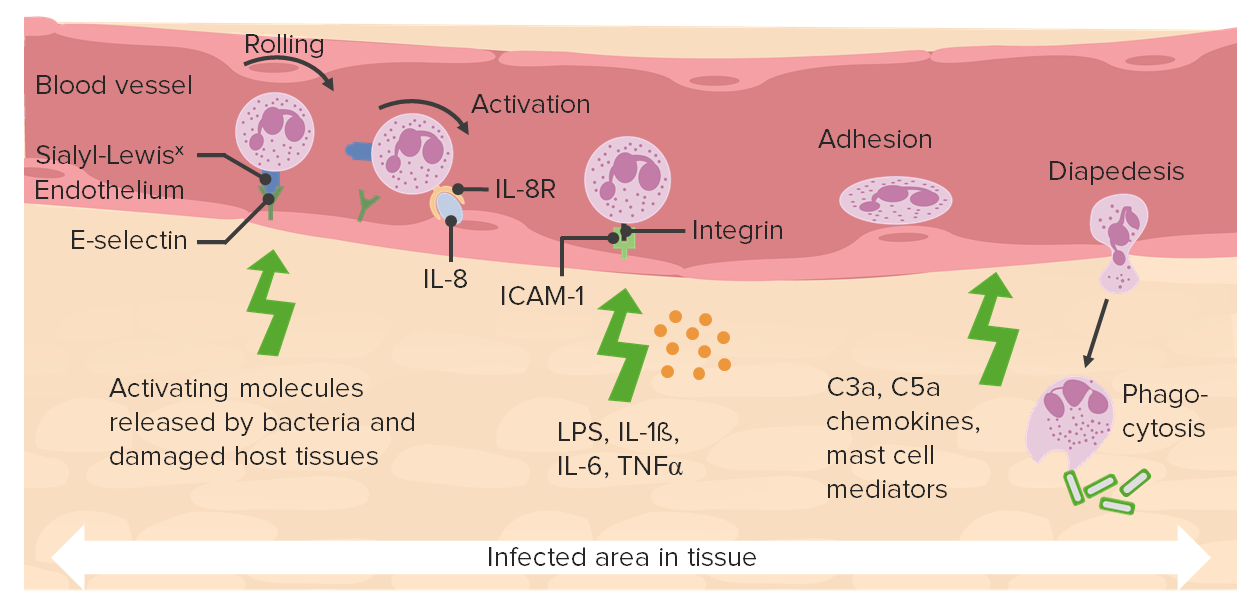Playlist
Show Playlist
Hide Playlist
Neutrophil Activation and Adhesion
-
Slides Acute and Chronic Inflammation Cellular response.pdf
-
Download Lecture Overview
00:00 So now they've rolled, they've slowed down, they've bumped along, and now they're getting to a point where they can have firm interaction. 00:09 And that's that stable adhesion. 00:11 Following stable adhesion, we're going to migrate across the endothelium. 00:15 Let's look at those next stages in detail. 00:18 So, firm adhesion is mediated by a different family of adherent molecules. 00:24 So you have integrins and their ligands. 00:28 On the endothelial cell, we have the ligands for integrins. 00:33 Those ligands are an immunoglobulin superfamily. 00:36 They're on the endothelium, they stick out, they have particular domains, as shown there with disulfide linkages. 00:42 They have names that are kind of boring, but you will hear them. 00:46 So, intercellular adhesion molecule 1 and 2, So, that's not a bad name. It's just kind of boring. 00:53 And then platelet endothelial cell adhesion molecule or CD31. 00:58 They have this general structure, and they sit on the endothelium. 01:01 What are they binding to? Well, on the other half of the equation, we have the leukocyte. 01:06 And the leukocyte has on its surface integrins. 01:10 Integrins are alpha and beta heterodimers. 01:13 There's lots of different proteins in this family, but they come out as pairs, and they have different affinities for different molecules. 01:23 They mediate not only cell-cell interactions, such as the inflammatory response, but we've seen integrins previously because they are the molecules that adhere epithelium to the basement membrane underneath it in hemidesmosomes. 01:39 What the integrins recognize as their receptor on the other cells, so this would be the immunoglobulin superfamilies. 01:47 They see specifically three amino acids: arginine-glycine-aspartic acid. It's a RGD motif. 01:54 And that motif of three amino acids occurs in the middle of a much larger protein as you see there, but that's what gets bound. 02:03 But we get specific interactions, because of the adjacent portions of the protein. 02:10 The alpha and beta chains can be many from the family and so you can get different alpha and beta heterodimers on any given cell. 02:18 And as we'll see on the next slide, that allows us to have some specificity of who gets recruited when? The specific ones involved in recruiting inflammatory cells are called Beta2-integrins. You may hear that. 02:31 They're also called leukocyte function-associated integrins. 02:36 And they are not active at baseline. 02:38 An important point, we have to activate them to get them to be maximally adherent and bind to that RGD motif. 02:48 So, as promised, neutrophils have a certain subset of alpha and beta heterodimers on their surface, which are different than the ones expressed on monocytes, which are different than the ones expressed on lymphocytes. 03:01 So you can see that depending on that integrin expression, and depending on the immunoglobulin superfamily, that they will be binding to, you can at different times recruit an endothelium neutrophils, or monocytes, or lymphocytes, and that gives you some specificity. 03:22 Do not memorize the names and the numbers and all of that. 03:25 The concept here is what's important that there is a unique expression, a particular integrins on different cell types. 03:33 And so initially, we will recruit neutrophils. 03:36 And then the endothelial cells will change what they express and then will recruit monocytes, and maybe even later will recruit lymphocytes. 03:44 So, these differences allow specificity in the recruitment by changing the cognate ligands. 03:50 Okay, the point about these integrins are not active at baseline. 03:55 So on the leukocyte, we have the integrins alpha and beta heterodimers. 04:00 And they're sitting there and kind of that closed configuration not very active. 04:05 We need to activate them. So this is an extra regulatory step. 04:10 And we activated by having chemokine specific molecules that bind to unique receptors that turn on the lymphocyte or the leukocyte in this particular case, and cause the integrins to change their conformation. 04:23 Now, they're in a form that will allow them to get very firm adhesion. 04:31 So we get increased avidity of the intergrins because of the stimulation activation through the chemokine and chemokine receptor interaction.
About the Lecture
The lecture Neutrophil Activation and Adhesion by Richard Mitchell, MD, PhD is from the course Acute and Chronic Inflammation.
Included Quiz Questions
Which of the following is true about integrins?
- They have some degree of specificity.
- They recognize the alanine-arginine-aspartic acid motif.
- They mediate low-affinity cell-cell interactions.
- They are formed of four subunits.
- They interact with selectins on the endothelial cells.
The chemokine-induced integrin activation leads to...?
- ...increased avidity of the integrins.
- ...increased specificity of the integrins.
- ...decreased specificity of the integrins.
- ...elongation of the beta subunit.
- ...shortening of the beta subunit.
Customer reviews
5,0 of 5 stars
| 5 Stars |
|
5 |
| 4 Stars |
|
0 |
| 3 Stars |
|
0 |
| 2 Stars |
|
0 |
| 1 Star |
|
0 |




